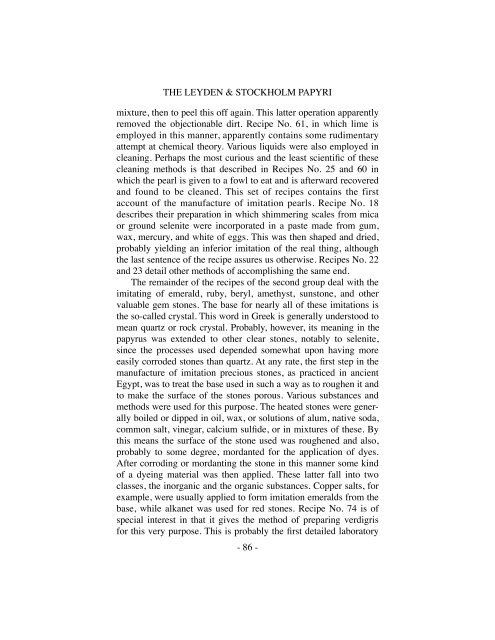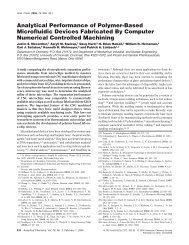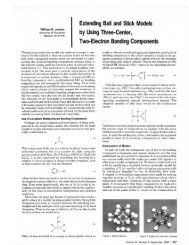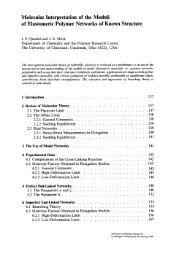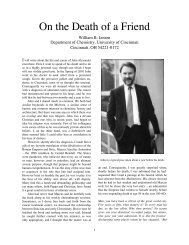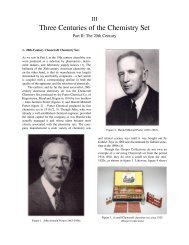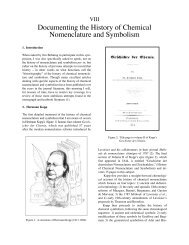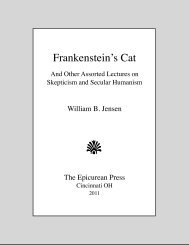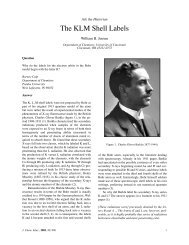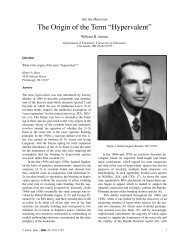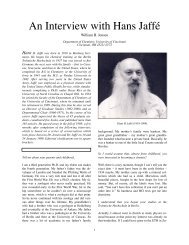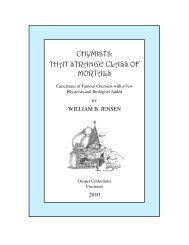The Leyden and Stockholm Papyri - University of Cincinnati
The Leyden and Stockholm Papyri - University of Cincinnati
The Leyden and Stockholm Papyri - University of Cincinnati
You also want an ePaper? Increase the reach of your titles
YUMPU automatically turns print PDFs into web optimized ePapers that Google loves.
THE LEYDEN & STOCKHOLM PAPYRI<br />
mixture, then to peel this <strong>of</strong>f again. This latter operation apparently<br />
removed the objectionable dirt. Recipe No. 61, in which lime is<br />
employed in this manner, apparently contains some rudimentary<br />
attempt at chemical theory. Various liquids were also employed in<br />
cleaning. Perhaps the most curious <strong>and</strong> the least scientific <strong>of</strong> these<br />
cleaning methods is that described in Recipes No. 25 <strong>and</strong> 60 in<br />
which the pearl is given to a fowl to eat <strong>and</strong> is afterward recovered<br />
<strong>and</strong> found to be cleaned. This set <strong>of</strong> recipes contains the first<br />
account <strong>of</strong> the manufacture <strong>of</strong> imitation pearls. Recipe No. 18<br />
describes their preparation in which shimmering scales from mica<br />
or ground selenite were incorporated in a paste made from gum,<br />
wax, mercury, <strong>and</strong> white <strong>of</strong> eggs. This was then shaped <strong>and</strong> dried,<br />
probably yielding an inferior imitation <strong>of</strong> the real thing, although<br />
the last sentence <strong>of</strong> the recipe assures us otherwise. Recipes No. 22<br />
<strong>and</strong> 23 detail other methods <strong>of</strong> accomplishing the same end.<br />
! <strong>The</strong> remainder <strong>of</strong> the recipes <strong>of</strong> the second group deal with the<br />
imitating <strong>of</strong> emerald, ruby, beryl, amethyst, sunstone, <strong>and</strong> other<br />
valuable gem stones. <strong>The</strong> base for nearly all <strong>of</strong> these imitations is<br />
the so-called crystal. This word in Greek is generally understood to<br />
mean quartz or rock crystal. Probably, however, its meaning in the<br />
papyrus was extended to other clear stones, notably to selenite,<br />
since the processes used depended somewhat upon having more<br />
easily corroded stones than quartz. At any rate, the first step in the<br />
manufacture <strong>of</strong> imitation precious stones, as practiced in ancient<br />
Egypt, was to treat the base used in such a way as to roughen it <strong>and</strong><br />
to make the surface <strong>of</strong> the stones porous. Various substances <strong>and</strong><br />
methods were used for this purpose. <strong>The</strong> heated stones were generally<br />
boiled or dipped in oil, wax, or solutions <strong>of</strong> alum, native soda,<br />
common salt, vinegar, calcium sulfide, or in mixtures <strong>of</strong> these. By<br />
this means the surface <strong>of</strong> the stone used was roughened <strong>and</strong> also,<br />
probably to some degree, mordanted for the application <strong>of</strong> dyes.<br />
After corroding or mordanting the stone in this manner some kind<br />
<strong>of</strong> a dyeing material was then applied. <strong>The</strong>se latter fall into two<br />
classes, the inorganic <strong>and</strong> the organic substances. Copper salts, for<br />
example, were usually applied to form imitation emeralds from the<br />
base, while alkanet was used for red stones. Recipe No. 74 is <strong>of</strong><br />
special interest in that it gives the method <strong>of</strong> preparing verdigris<br />
for this very purpose. This is probably the first detailed laboratory<br />
- 86 -


